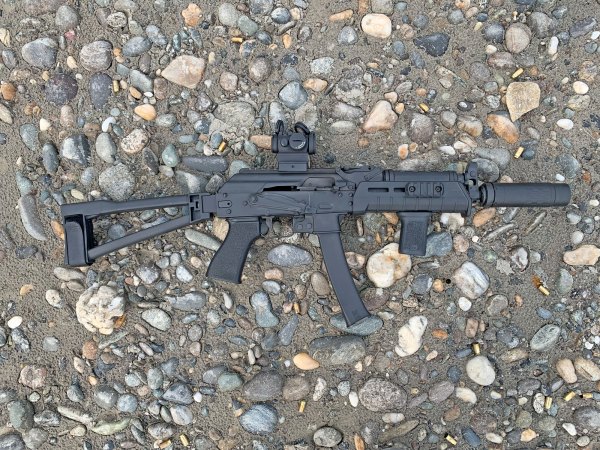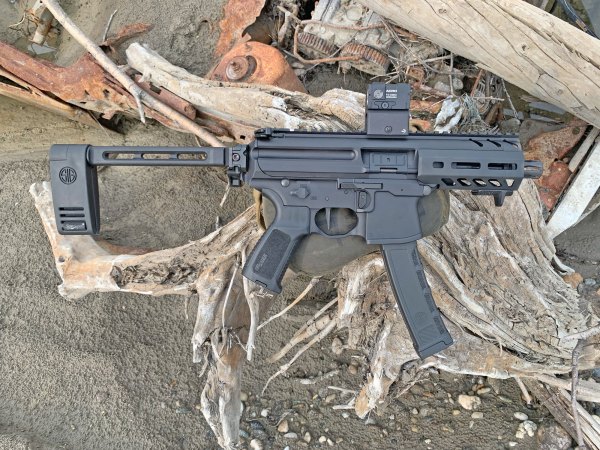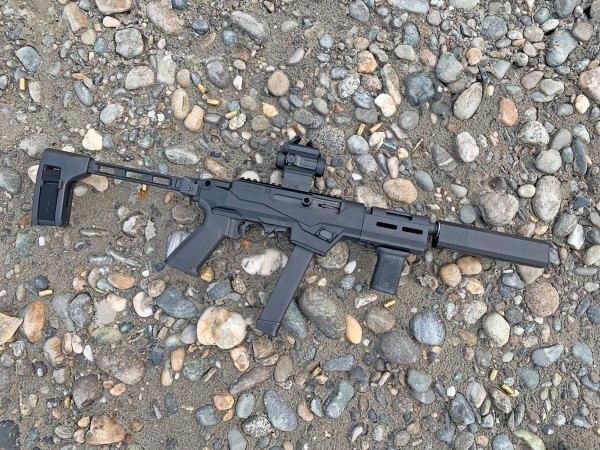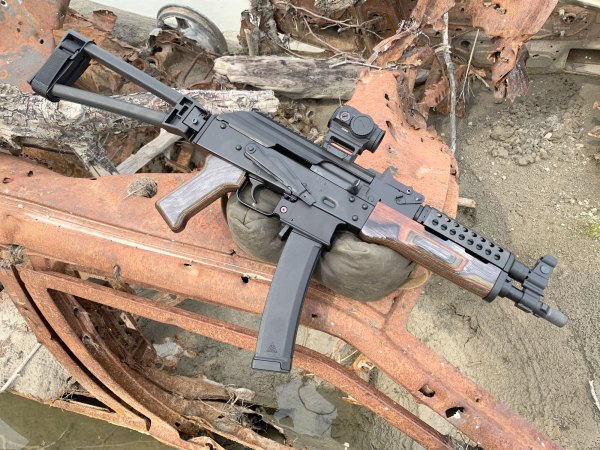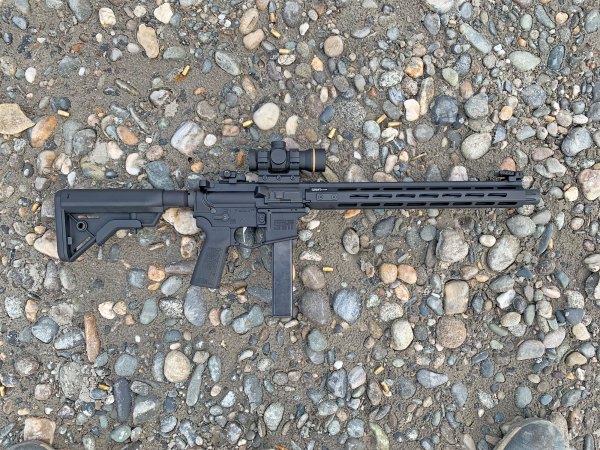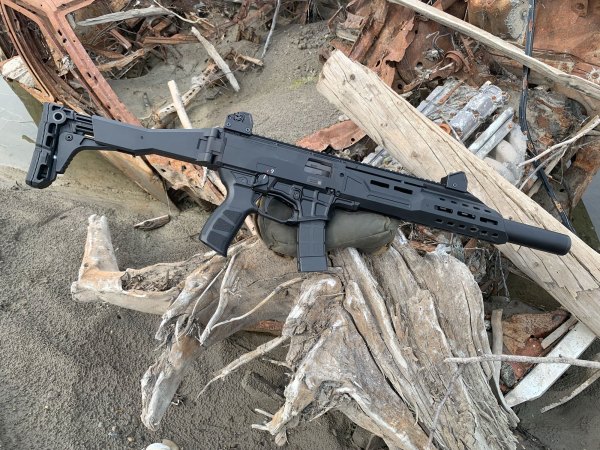We may earn revenue from the products available on this page and participate in affiliate programs. Learn More ›
I’m not sure when the first 9mm carbine was assembled, but not long after the cartridge debuted in the Luger pistol, people recognized the benefits of running the cartridge through a shoulder-fired gun. Early 9mm carbines were simply pistols with detachable stocks and appeared on Luger vaariants, C96 Mauser broomhandle pistols, and even early World War II pistols like the Polish Radom VIS P35. That quickly led to development of submachine gun platforms and the rest is history.
The 9mm cartridge has been adopted in countless carbines over the years, the trend that remains strong as ever. Being that the term “carbine” is generally defined as “a firearm similar to a lightweight rifle, but with a shorter barrel,” there are a lot of designs that fall within this category. Generally though, 9mm carbines and other pistol caliber carbines (PCCs) are compact, blowback-operated, semi-automatic rifles or braced pistols. A 9mm carbine is one of the most enjoyable firearms to shoot, and they have a number of practical applications.
What Is A 9mm Carbine Good For?
The early 9mm carbine was typically a combat-oriented weapon, and they still excel in that application. They are usually shorter and lighter than a rifle, with less recoil and greater ammunition capacity. They’ve been used in military and police employment for decades, but their usefulness stretches beyond those applications.
Self Defense or Home Defense
Given the widespread use of the 9mm carbine in the law enforcement and military arenas, it is logical that they’d make practical and effective tools for self defense. They’re typically more accurate, have higher ammunition capacity, and are easier for newer shooters to reach proficiency than with many handguns, shotguns or rifles.
Many of them are small enough to comfortably use in tight spaces and can be stowed safely and discreetly in the home or vehicle, and with purpose-designed defensive 9mm ammunition, the risk of over penetration from rifle rounds such as the .223 or 5.56 is decreased.
Survival and Small-Game Hunting
The 9mm is a slow, short-range cartridge that isn’t generally suitable for hunting large game, but in a 9mm carbine, it can be an effective option for a survival or bug-out gun, or for hunting small game. Though larger than small-game classics like the .22 LR and .22 WMR, the 9mm can be quite effective and isn’t too destructive when using appropriate ammunition. An advantage to using a 9mm carbine as a truck, boat, or backpack gun is the relative affordability and abundance of 9mm ammo. Another plus is that most platforms can utilize higher-capacity magazines. Along with .223/5.56 and .22 LR, the 9mm is one of the best survival/prepper cartridges you can pick.
Recreational and Competitive Shooting
The 9mm carbine is one of the funnest platforms to shoot. Low recoil, muzzle blast, and inexpensive ammo all make it so. Only the .22 LR can eclipse the 9mm carbine when it comes to pure plinking and steel-plate-shooting delight. In fact, if you can get through a 30-round magazine from a 9mm carbine without cracking a smile, you probably should be working in a basement at the IRS.
In recent years, pistol caliber carbine divisions in competitive organizations such as USPSA have become wildly popular. Shooters develop and exercise the same practical shooting skills as they would with pistols. This popularity has inspired a slew of high-performance competition-oriented 9mm carbines too.
How We Selected and Tested Each 9mm Carbine
It would be a monumental and impractical feat to test every 9mm carbine on the market. And that would, frankly, leave a prospective customer more befuddled by all the available options.
To give you a peek into the world of the 9mm carbine, I selected six different models, outfitted them with optics, suppressors, and other accessories, and shot the hell out of them. I tested their function with several types and weights of common 9mm ammunition and tested their accuracy by recording and averaging four 5-shot groups at 25 yards with Staccato Match 125gn 9mm ammo. For practical shooting, I ran plate racks and other steel targets from 10 to 50 yards, noting both positives and negatives. There are many other excellent 9mm carbines out there, and as we get to evaluate more of them, we will update this story.
Some of Our Favorite 9mm Carbines: Reviews and Recommendations
If the perfect 9mm carbine or PCC for you isn’t on this list, I’d bet that it will be something similar to one of these models:
Best Overall: Kalashnikov USA KP-9
Key Features
- Style: AK variant
- Overall length: 19.75 inches (folded), 28 inches (brace extended)
- Barrel length: 9.25 inches
- Muzzle: threaded ½-28, includes compensator
- Trigger: 1 pound, 14 ounces (aftermarket ALG AK trigger)
- Capacity: 30+1
- Folding brace/stock compatible
- Iron sights: Yes, AK-style
- Accuracy average: .931 inches (4 5-shot groups at 25 yards)
- Price: $1,200
Pros
- Dependable with all common types of ammunition
- Compatible with many AK accessories and folding braces or stocks (for registered short-barreled-rifles)
- Good accuracy
- Simple to maintain
Cons
- Expensive magazines
- Doesn’t come with brace
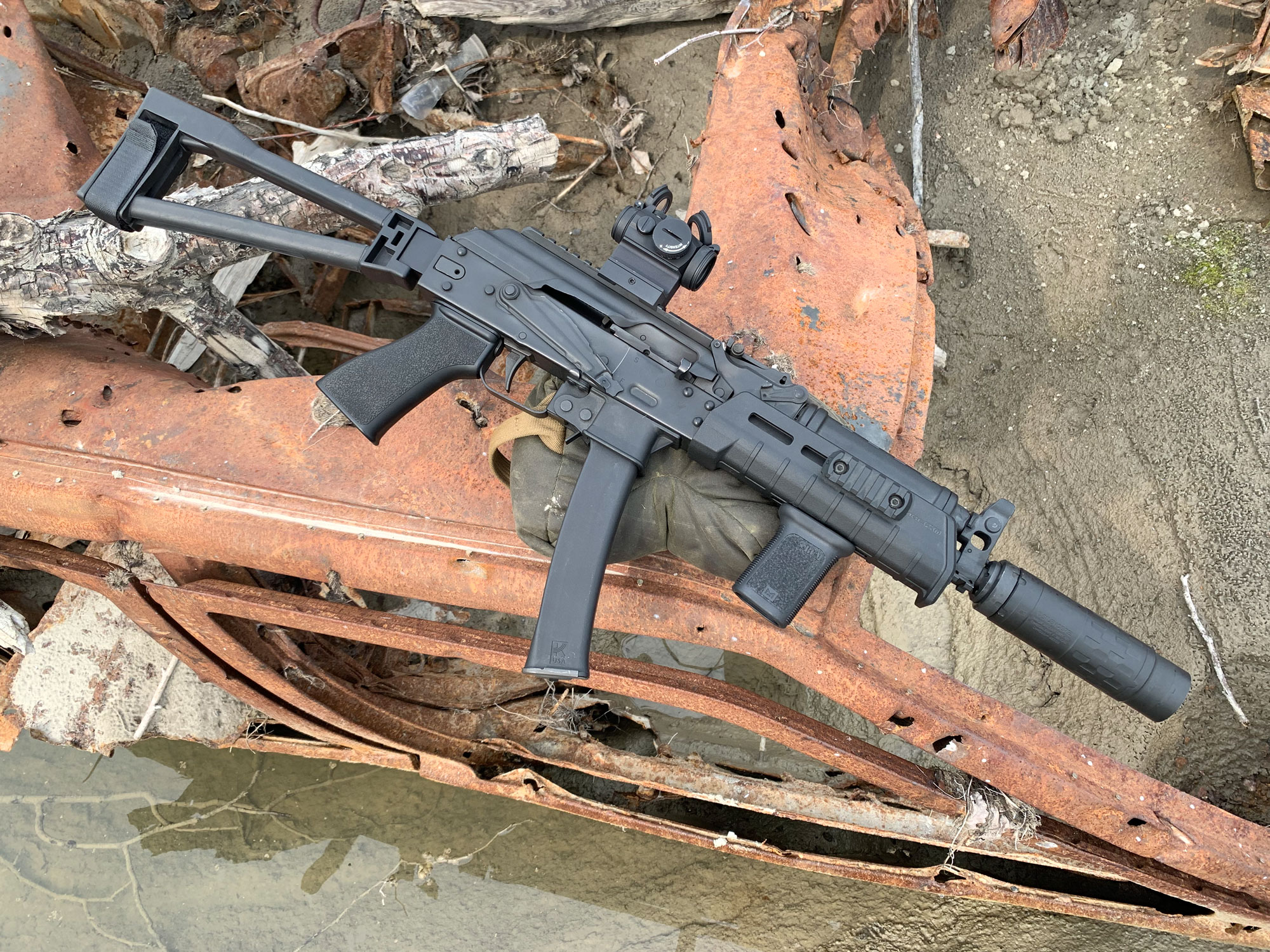
The KP-9 from Kalashnikov USA is the pistol version of the company’s KR-9 rifle — and an almost exact semi-automatic copy of the Russian Vityaz submachine gun. Bare bones, this pistol is about $1,100 to $1,200, but is compatible with triangle folding braces or stocks (if you want to register it as an SBR). It has a 9.25-inch barrel that comes with a genuine Vityaz-style compensator, but it’s threaded ½-28 making it compatible with other widely-available muzzle devices and suppressors. I fitted my personal SBR with a Silencerco three-lug mount.
The KP-9 is a blowback-operated semi-auto that strips down similarly to gas-driven AK rifles, except that it doesn’t have a functional piston. It field-strips easily and isn’t scared of a little bit of carbon fouling. The stock trigger is typical of the AK variety — stiff with lots of creep — and I replaced mine with an ALG aftermarket trigger. It has a polymer magwell riveted to the receiver, which mimics the genuine Vityaz and has held up well over several years of use for me. A key feature for reliability, the KP-9 has modified feed ramps to facilitate smooth loading of JHP and truncated bullets.
Set up with a tax stamp and aftermarket goodies has certainly elevated the appeal of my personal KP-9, so it’s important to remember that when comparing the retail price with other 9mm carbines. However, this has been an incredibly dependable and insanely fun gun. It’s one of the most accurate that I’ve tested and pairs well with a suppressor and subsonic ammo.
Best Compact 9mm Carbine: Sig Sauer MPX K
Key Features
- Style: Bufferless AR style
- Overall length: 14.33 inches (folded), 22.25 inches (brace extended)
- Barrel length: 4.5 inches
- Muzzle: threaded M13.5x1mm, includes A2-style flash hider
- Trigger: 4 pounds, 6 ounces (measured)
- Capacity: 35+1
- Folding brace included
- Iron sights: No
- Accuracy average: 1.366 inches (4 5-shot groups at 25 yards)
- Price: $2,219
Pros
- Compact
- Good trigger
- AR-style receivers and controls
- Ambidextrous controls
Cons
- Barrel is almost too short
- Non-standard muzzle threads
Sig’s MPX K is one of the coolest and most compact 9mm carbines you will find. They have a number of iterations of the MPX, including a longer-barreled competition version, but the MPX K is a 9mm carbine that’s more suited for being a high-performance bug-out bag or truck gun. It’s got a short 4.5-inch barrel that’s surrounded by an aluminum M-Lok handguard, and uses AR-style upper and lower receivers. There’s no buffer tube on these, and the recoil springs are located below the charging handle and above the bolt. Unlike their 5.56mm carbines, the MPX is blowback operated and doesn’t use a gas piston.
These are some of the more expensive pistol caliber carbines you can buy, but they’re high quality and mine has been utterly reliable. I set mine up with an Aimpoint ACRO red dot on a B&T riser, and it made this 9mm carbine easy to maneuver, aim, and shoot quickly out to 50 yards or so. It has a good trigger and smooth recoil impulse. For its compact size, it surprised me how quickly I could blast through a plate rack without misses.
Aside from a hefty price tag, the only downsides of the MPX K come with its barrel. Most prominently, Sig uses an M13.5x1mm left-hand-thread for its muzzle, which greatly limits the aftermarket accessories you can use with it. Second, the barrel on the MPX K is almost too short to be safely handled without a suppressor attached. This platform begs to be suppressed, but it’s not as convenient with that thread pattern. I installed a hand stop at the front of the handguard to prevent accidental slippage, but as a registered SBR, a vertical grip could be installed, which would be better. The braced pistol version of this platform is very cool, but if you’re going to invest in an MPX, you’ll probably want to bite the bullet and just get your SBR tax stamp.
Best Value 9mm Carbine: Ruger PC Charger
Key Features
- Overall length: 16.75 inches (folded), 25.25 inches (SB 1913 brace extended)
- Barrel length: 6.5 inches
- Muzzle: threaded ½-28, includes thread protector
- Trigger: 4 pounds, 9 ounces (measured)
- Capacity: 17+1
- Folding brace/stock compatible (Picatinny rail)
- Iron sights: No
- Accuracy average: 2.242 inches (4 5-shot groups at 25 yards)
- Price: $650
Pros
- Affordable and versatile
- Compatible with Glock magazines
- One-turn takedown
- Reliable
Cons
- Trigger has long reset
- Doesn’t come with brace

When it comes to bang for the buck, it’s hard to beat Ruger’s PC Charger for a 9mm carbine — whether you want to use it as a braced pistol or turn it into an SBR. Technically the pistol variant of Ruger’s popular PC Carbine, the PC charger is an affordable, versatile, and reliable 9mm carbine. It doesn’t include a brace, but at the rear of the chassis is a section of M1913 Picatinny rail that’s compatible with a variety of options. This PCC resembles an up-sized 10/22 with even more features. The receiver sits in an aluminum chassis and features a quick-detach takedown barrel and M-Lok handguard assembly.
The PC Charger comes set up to accept 17-round Ruger pistol magazines, but includes a conversion kit to use Glock and aftermarket Glock-style magazines — something you’ll want to install immediately. When comparing all these pistol caliber carbines, I noted that with the Glock magazines, the PC Charger was the easiest to load — magazines float effortlessly up into the magwell, directed by its polymer edges. One thing I really like about this 9mm carbine is that the bolt handle can be installed on either side of the receiver, as can the magazine catch button.
Accuracy of the PC Charger isn’t great, and the trigger is so-so, with a long reset. The recoil impulse, though not hard, is a bit more jumpy with this than most of the other PCCs I evaluated. My PC Charger is an SBR, so I installed a vertical fore grip, and it’s gleeful to shoot when paired with my Silencerco Osprey 2.0 suppressor.
PSA Soviet Arms AK-V Voodoo
Key Features
- Style: AK variant
- Overall length: 19.75 inches (folded), 28.25 inches (brace extended)
- Barrel length: 10.5 inches
- Muzzle: threaded ½-28, includes side-baffle brake
- Trigger: 1 pounds, 13 ounces (measured)
- Capacity: 35+1
- Folding triangle brace included (Picatinny mounted)
- Iron sights: Yes, AK-style
- Accuracy average: .667 inches (4 5-shot groups at 25 yards)
- Price: $1,025
Pros
- Good workmanship and feature set
- Compatible with many AK accessories and mods
- Excellent accuracy
- Affordable magazines
Cons
- Doesn’t function well with some JHP and truncated bullets
Another highly popular 9mm carbine is the AK-V 9mm from Palmetto State Armory. They offer several different variants, but I opted to test the Voodoo model with brown/green laminated furniture and a ventilated “cheese grater” style upper handguard. This braced pistol ships with a folding triangle brace, though since it features a Picatinny mount, the gun is compatible with others too. Where the Kalashnikov KP-9 strives for an authentic Vityaz look, the AK-V sports modernized lines on the dust cover and a beefier magwell and paddle mag release. It’s nicely executed.
Like the KP-9, the AK-V operates much like an AK rifle but, since it’s recoil operated, it doesn’t have a gas piston. The trigger is pretty light with quite a bit of creep, but it’s better than the factory AK trigger on the KP-9. The AK-V has a smooth-operating three-position safety/selector, which is a nod to the genuine submachine gun, even though these are semi-auto only.
One thing I appreciate about the AK-V is its use of CZ Scorpion pattern magazines. Mags from PSA hold 35 rounds and are pretty affordable at around $17 apiece. Compare that to $45 apiece for Sig MPX mags. This gun was the most accurate PCC that I tested, and clustered shots tightly at 25 yards. It’s smooth recoiling and allows fast target transitions. My only complaint is that the feed ramps, based on an older design meant for ball ammo, didn’t work as well with 147-grain truncated bullets and some JHP bullets. I prefer shooting 147-grain subsonics when using a suppressor, so that’s an issue. Overall though, it’s a great value for a 9mm carbine.
Springfield Armory Saint Victor 9mm Carbine
Key Features
- Style: AR Variant
- Overall length: 31.5 inches (stock collapsed), 35 inches (stock extended)
- Barrel length: 16 inches
- Muzzle: threaded ½-28, includes blast diverter
- Trigger: 5 pounds, 4 ounces (measured)
- Capacity: 32+1
- Iron sights: flip-up peep and post
- Accuracy average: .841 inches (4 5-shot groups at 25 yards)
- Price: $1,220
Pros
- Great accuracy
- AR style works well with aftermarket triggers and other mods
- Long barrel and handguard are ideal for competitive shooting
- Collapsible buttstock
Cons
- Magazine is difficult to load
- Heavy trigger
The AR-style 9mm carbine was most famously introduced by Colt in 1982 as the model 635 submachine gun. It replicated the ergonomics, features, and handling of an AR carbine, but in a 9mm blowback-operated version. There are many variations today, and I tested Springfield Armory’s Saint Victor — a 16-inch barreled carbine that features a full-length M-Lok handguard and uses Colt-pattern 32-round magazines, which were originally modified versions of the Uzi magazine. Those magazines are double-stack, made of steel, and a bitch to load. But the one that came with the rifle functioned perfectly.
With a 16-inch barrel, this model is considered a long gun, so there’s no NFA tomfoolery necessary to outfit it with whatever accessories you want. The barrel comes capped with a blast diverter, and is threaded ½-28 — though I was unable to get the blast diverter to break loose and stopped short of using a torch to convince it. The muzzle is actually recessed inside the handguard too, so not all suppressors will fit. It has an ambidextrous 45-degree safety selector and pop-up iron sights, though it’s a perfect platform for a red dot.
This is a great option for short-range carbine applications or competition. The long handguard gives the shooter ample control, and though the trigger is heavy, it has a strong reset and can be run very fast. An aftermarket drop-in trigger would really let this thing hum. This would be an excellent PCC to start a new shooter on and familiarize them with AR ergonomics too.
Henry Homesteader 9mm Carbine
Key Features
- Overall length: 35.75 inches
- Barrel length: 16.37 inches
- Muzzle: threaded ½-28, includes thread protector
- Trigger: 6 pounds, 10 ounces (measured)
- Capacity: 5+1, 10+1, compatible with other mags
- Iron sights: Peep rear, post front
- Accuracy average: 1.974 inches (average of 5-shot groups at 50 yards)
- Price: $714
Pros
- Traditional style
- Works with OEM Sig, Glock, and S&W magazines
- Good accuracy
- Great trainer for young hunters
Cons
- Not much accessory compatibility
- Recoil pad is unnecessarily plush
Borrowing from earlier testing and evaluation we’ve done, I had to include the Henry Homesteader in this lineup. The 9mm carbine market is full of tactical-looking options, but some folks want a more classic-looking PCC. This semi-auto comes with wood furniture and the aura of a modern saddle gun. It features a barrel-mounted rear peep and front post, but you can easily mount a red dot or magnified optic atop the receiver.
This is a good-looking carbine that’s more versatile than it might seem at first glance. You can adapt it to use magazines from Glock, Sig, or Smith & Wesson, so it probably pairs with a handgun you already have. At the very least, you will have no trouble finding affordable spare magazines. The muzzle is threaded for a suppressor and comes with a thread protector. A little can like the Silencerco Omega 36M in short configuration would pair perfectly with it.
If you want to read more in-depth about the Homesteader, shooting editor John B. Snow wrote this glowing review, and the Outdoor Life test team couldn’t put it down at our 2023 Gun Test. I don’t think you will be able to either.
CZ Scorpion Evo 3+ 16-inch 9mm Carbine
Key Features
- Overall length: 24.75 inches (stock folded), 35 inches (stock fully extended)
- Barrel length: 16 inches
- Muzzle: threaded ½-28, features faux suppressor with blast diverter
- Trigger: 8 pounds, 5 ounces (measured)
- Capacity: 20+1
- Iron sights: Rail-mounted sights, rear peep has 4 different aperture sizes
- Accuracy average: .854 inches (4 5-shot groups at 25 yards)
- Price: $1,002
Pros
- Great accuracy
- Ambidextrous controls
- Good accessory compatibility
- Buttstock folds but also adjustable for length
Cons
- Folding stock button is very difficult to press
- Very heavy trigger
- Receiver and rails are polymer shell
The CZ Scorpion is yet another iconic 9mm carbine that I was able to get my hands on. Though the Evo 3+ and earlier iterations are mechanically dissimilar, many people incorrectly associate them with the original .32 ACP Scorpion submachine guns that came around in the late 1950s. The Scorpion EVO 3 + carbine is a semi-automatic 9mm PCC that has good ergonomics as well as some unique and interesting features. It’s a modern-looking gun with a clamshell-type polymer receiver which houses the large bolt assembly and recoil spring.
This gun features a removable trigger pack and a lot of adjustability. You can adjust the telescoping stock for length, and the grip can even be moved forward or backward to fine-tune trigger reach. The rear sight is an adjustable peep that features four different aperture sizes the shooter can flip through. This 16-inch model is legally a long gun, but made to look like a shorter-barreled version with a suppressor attached. The faux suppressor slips over the barrel and has a blast diverter at the front. It looks cool, but if you pull it to install a suppressor, it turns into a dork. Fortunately, if you start out with this carbine and file a form 1 to make it an SBR, you can get shorter aftermarket barrels to pair with your favorite can — making it exponentially cooler.
The Scorpion Evo 3+ was quite accurate and fun to shoot, though it has a very heavy trigger and sometimes uncomfortable hand shock through the pistol grip when firing. This 9mm carbine only ships with one 20-round magazine, but it’s compatible with the previously mentioned Palmetto AK-V mags. They generally seem to work well, but some don’t fit as smoothly and I had issues with truncated 147-grain bullets feeding in the Scorpion too.
FAQ
That depends on the context. The 9mm cartridge can be lethal at very long distances, but it’s only practically effective to perhaps 50 or 100 yards — meaning it can be fired accurately and the bullets maintain enough velocity to function properly.
Local laws vary, but in most states, pistol caliber carbines or 9mm carbines are legal. Some are considered pistols and can only be used with approved brace devices. Putting certain things like a stock or vertical forward grip on a firearm that’s manufactured as a pistol without registering as an SBR is a felony. Here are the ATF guidelines.
That depends on application. For competition, 115- or 124-grain bullets might give the best trajectory or accuracy, but if you’re using a suppressor, heavier 147-grain subsonic bullets are a better option.
Yes, because of the additional velocity that .30 Carbine has — with a similar bullet weight — it is technically more powerful.
Final Thoughts on the 9mm Carbine
Many hunters overlook the 9mm carbine, but it’s a type of firearm that’s both insanely fun and useful. Whether you’re interested in one for self defense, fun at the range, competition, or all of the above, you’ve got a lot of great options.

